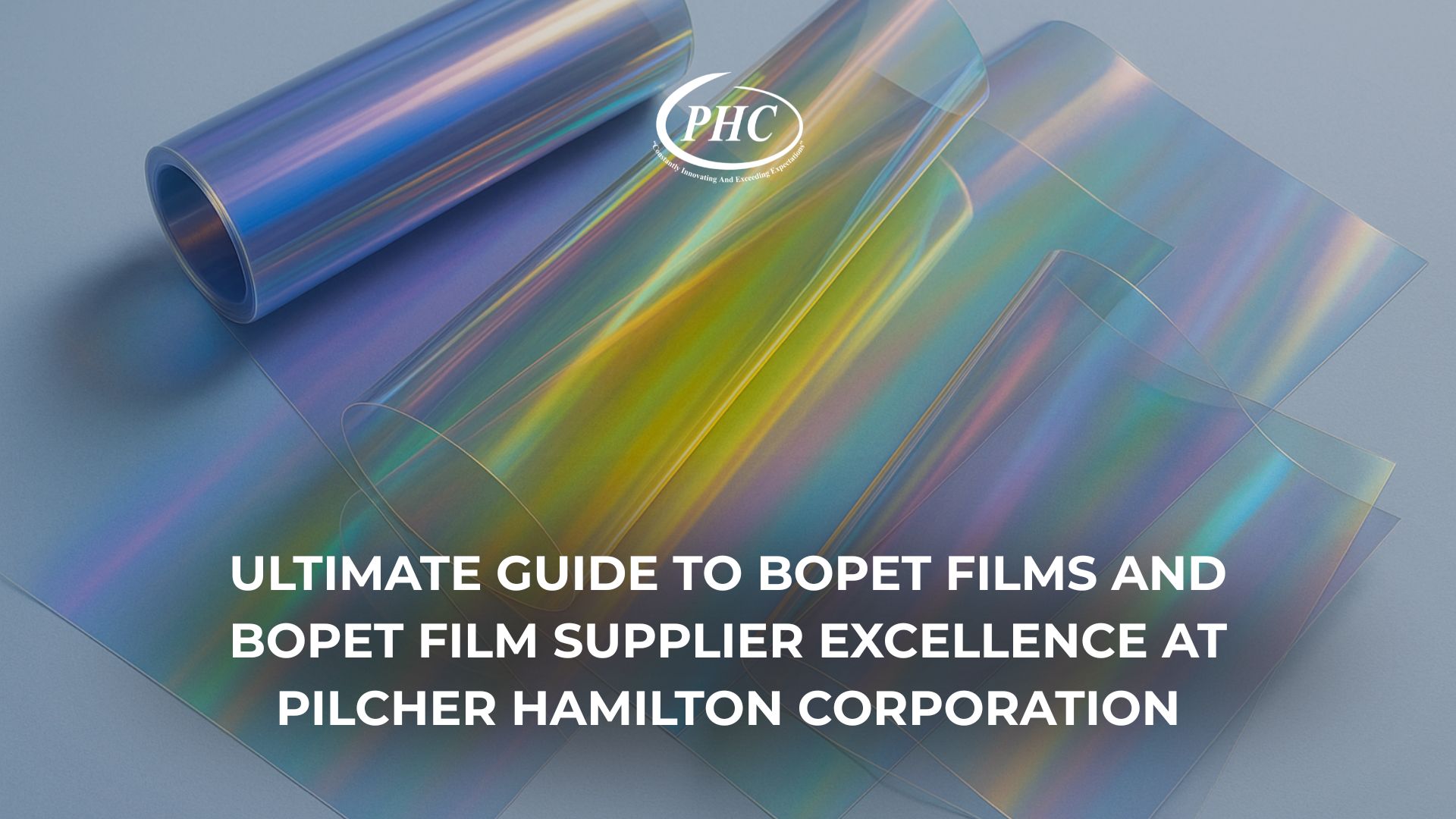- What are BOPET Films?: BOPET, or biaxially oriented polyethylene terephthalate, is a high-performance polyester film produced by stretching PET resin in both machine and transverse directions. This process enhances its strength, clarity, and barrier properties, making it a versatile material for various industries.
- Why It Matters?: BOPET films offer superior mechanical strength, thermal stability, and barrier performance against oxygen, moisture, and aromas. They enable sustainable packaging solutions, reduce material usage, and support circular economy initiatives through recyclability and post-consumer recycled (PCR) content integration.
- Who It’s For?: Ideal for engineers, buyers, and operations leaders in packaging, electrical insulation, graphics, and industrial sectors seeking reliable, customizable films with quick lead times and U.S.-based converting.
- Pilcher Hamilton Expertise: As a leading U.S. BOPET film supplier since 1904, Pilcher Hamilton Corporation at 850 South Buncombe Road, Greer, South Carolina, provides premium films with services like slitting, coating, and toll converting for optimal performance.
What Are BOPET Films and Their Core Properties?
BOPET films, also known as biaxially oriented polyethylene terephthalate, represent a cornerstone of modern materials engineering. Derived from polyethylene terephthalate (PET) resin, these films undergo a sophisticated production process involving extrusion, followed by sequential or simultaneous stretching in two perpendicular directions. This biaxial orientation aligns the molecular chains, imparting exceptional properties that distinguish BOPET from other polymer films.
The manufacturing begins with PET pellets melted and extruded into a flat sheet. Cooling solidifies the amorphous structure, after which the film is stretched longitudinally (machine direction) and transversely. Typical stretch ratios range from 3:1 to 4:1 in each direction, followed by heat-setting to lock in the orientation. This results in a film with high tensile strength, dimensional stability, and optical clarity.
Core properties include:
- Mechanical Strength: BOPET exhibits tensile strengths of 200-250 MPa in both directions, with elongation at break around 100-150%. This makes it resistant to tearing and puncturing, ideal for demanding applications.
- Thermal Stability: With a melting point near 260°C and glass transition temperature of 70-80°C, BOPET withstands temperatures from -70°C to 150°C without significant degradation.
- Barrier Performance: Untreated BOPET has oxygen transmission rates (OTR) of 100-150 cc/m²/day and moisture vapor transmission rates (MVTR) of 20-30 g/m²/day at standard conditions. Coated or metallized variants can reduce these to below 1 cc/m²/day and 1 g/m²/day, respectively.
- Optical Properties: High clarity (light transmission >90%) and low haze (<1%) suit it for graphic and display uses.
- Electrical Insulation: Dielectric strength of 150-200 kV/mm and volume resistivity >10^17 ohm-cm make it excellent for insulators.
- Chemical Resistance: Inert to most solvents, acids, and bases, enhancing durability.
At Pilcher Hamilton Corporation, a premier BOPET film supplier, we source high-quality base films and enhance them through value-added processes. For instance, our corona-treated BOPET films achieve surface energy levels of 42-56 dyne/cm, boosting adhesion for printing and lamination. Searching for “BOPET near me” often leads to our Greer, SC facility, where we maintain inventory for rapid delivery.
Expanding on production innovations, recent advancements as of 2025 include integration of PCR content up to 90% in select grades, reducing carbon footprint while maintaining properties. Sustainable manufacturing emphasizes energy-efficient extrusion and recycling loops, aligning with circular economy principles.
In terms of variations, BOPET films come in plain, coated, metallized, and specialty types. Acrylic-coated versions offer dyne levels around 48-52 for superior printability, while silicone-coated provide release properties with low COF (0.2-0.4). Pilcher Hamilton excels in customizing these, ensuring compliance with U.S. standards like FDA for food contact.
BOPET film manufacturies have evolved, with U.S. hubs in South Carolina leading in efficient, low-emission processes. Our expertise positions us as a top BOPET film supplier, offering films with precise gauges from 12 µm to 250 µm.
Detailed property analysis reveals BOPET’s Young’s modulus of 4-5 GPa, far surpassing LDPE’s 0.2 GPa, enabling thinner films without sacrificing strength. Thermal expansion coefficient is low (15-20 ppm/°C), ensuring stability in varying environments.
For electrical applications, BOPET’s low dissipation factor (0.002-0.005) minimizes energy loss in capacitors and insulators. In packaging, its aroma barrier preserves flavors, crucial for food and pharma.
Pilcher Hamilton’s BOPET offerings include anti-fog grades with hydrophilic coatings, reducing condensation for clear visibility in fresh produce packaging. Metallized BOPET, with aluminum layers, achieves OTR <1 cc/m²/day, extending shelf life.
As a BOPET film supplier in Greer, SC, we emphasize local sourcing to cut lead times to 24-48 hours. If you’re searching “BOPET near me,” our facility at 850 South Buncombe Road is your go-to.
BOPET film manufacturies focus on quality assurance, with inline monitoring for defects, ensuring haze <0.5% and uniformity.
In summary, BOPET’s core properties stem from its oriented structure, offering a balance of strength, barrier, and versatility unmatched by many alternatives.
Key Applications in Packaging, Electrical & Graphics
BOPET films find extensive use across industries due to their robust properties. In packaging, they serve as barrier layers in flexible pouches, stand-up bags, and lids, protecting contents from moisture and oxygen.
- Food Packaging: Metallized BOPET in snack bags provides OTR <1 cc/m²/day, preserving crispness. Heat-sealable grades enable peelable seals with strengths of 2-5 N/15mm.
- Pharmaceutical Packaging: PVDC-coated BOPET offers MVTR <0.5 g/m²/day, ideal for blister packs and sachets, complying with USP standards.
- Industrial Packaging: Twistable clear metallized BOPET for candy wrappers combines aesthetics with functionality, twisting without cracking.
In electrical applications:
- Insulation: UL-approved BOPET films insulate motors and transformers, with dielectric breakdown >10 kV for 50 µm thickness.
- Capacitors: High clarity grades ensure low defect rates, supporting capacitance stability.
- Flexible Electronics: Corona-treated BOPET substrates for printed circuits, with surface energy >50 dyne/cm for ink adhesion.
Graphics sector benefits:
- Labels and Overlays: Acrylic-coated BOPET for digital printing, accepting inks with dyne levels 44-48.
- Signage: Opaque white BOPET for backlit displays, with light diffusion properties.
- Laminations: Silicone-coated release films facilitate easy peeling in graphic arts.
Pilcher Hamilton, a leading BOPET film supplier, customizes for these uses via slitting to tolerances ±0.005 inches and coating for specific COF.
Case example: A food packer used our PCR heat-sealable BOPET, reducing virgin plastic by 50%, maintaining seal integrity at 120-150°C.
Searching “BOPET near me” connects you to our Greer, SC hub for tailored solutions.
BOPET film manufacturies produce variants like high COF low slip for stacking stability in graphics.
Benefits include cost savings through down-gauging, e.g., 12 µm BOPET replacing thicker films without performance loss.
In pharma, anti-fog BOPET prevents visibility issues in humid conditions.
Electrical uses leverage low shrinkage (<1% at 150°C), ensuring reliability.
Graphics appreciate high gloss (>150 GU) for vibrant prints.
Our toll converting turns base BOPET into application-ready rolls, with lead times under a week.
Advantages Over Traditional Materials
BOPET films outperform alternatives like PVC, LDPE, and paper in key metrics.
| Property | BOPET | PVC | LDPE | Paper | Aluminum Foil |
| Tensile Strength (MPa) | 200-250 | 50-80 | 10-20 | 30-60 | 70-100 |
| OTR (cc/m²/day) | 100-150 (plain), <1 (metallized) | 50-200 | 5000+ | High | <0.1 |
| MVTR (g/m²/day) | 20-30 (plain), <1 (coated) | 10-50 | 10-20 | High | <0.1 |
| Thermal Resistance (°C) | -70 to 150 | -30 to 70 | -50 to 80 | Up to 100 | High |
| Recyclability | High (PET #1) | Moderate | High | High | High |
| Cost Efficiency | Medium | Low | Low | Low | High |
| Environmental Impact | Low with PCR | High (chlorine) | Medium | Low | High energy |
BOPET’s superior strength allows thinner gauges, reducing material use by 20-30%. Barrier properties extend shelf life, cutting food waste.
Vs. PVC: BOPET avoids plasticizers, meeting stricter regulations.
Vs. LDPE: Better clarity and printability for premium packaging.
Vs. Paper: Moisture resistance without coatings.
Vs. Foil: Lighter weight, lower cost for similar barriers when metallized.
Pilcher Hamilton’s BOPET offerings, as a top supplier, include sustainable PCR variants, enhancing eco-advantages.
In electrical, BOPET’s insulation beats paper’s hygroscopic nature.
Graphics favor BOPET’s dimensional stability over PVC’s shrinkage.
Overall, BOPET balances performance, cost, and sustainability.
Future Trends in Sustainable BOPET Films
Sustainability drives BOPET evolution. PCR integration reaches 90%, maintaining properties while cutting emissions 50-70%.
Circularity focuses on mono-material structures for easier recycling.
Bio-based PET from plant sources emerges, though scaling lags.
Innovations include nano-coatings for barriers without multi-layers.
US compliance emphasizes FDA, USDA bio-preferred.
Pilcher Hamilton leads with PCR BOPET, twistable metallized for candy, heat-sealable with seal initiation 90-110°C.
Dyne levels in sustainable films hold at 38-44 post-treatment.
Future: Degradable additives for end-of-life.
As BOPET film supplier, we align with trends via regional sourcing.
BOPET near me searches highlight our Greer hub’s low-carbon logistics.
BOPET film manufacturies adopt green energy, reducing footprint.
H2: History of Pilcher Hamilton Since 1904
Pilcher Hamilton Corporation traces roots to 1904, founding as a supplier of industrial materials. Early focus on textiles evolved to polymers post-WWII.
By 1950s, embraced PET films as Mylar® emerged.
1970s-80s: Expanded converting with slitting, coating.
1990s: Added toll converting, emphasizing quality.
2000s: Sustainability push with PCR.
Today: U.S. authority in BOPET, Greer facility central.
Milestones: 1904 founding, 1954 PET adoption, 2004 centennial with green initiatives.
Mission: Partnerships via quality products/services.
Vision: Lead in sustainable BOPET.
Local authority in Greer, SC; search BOPET near me.
BOPET film manufacturies benefit from our legacy.
H2: Core Services: Slitting, Coating, Toll Converting, Sheeting, Winding
Pilcher Hamilton excels in converting.
Slitting: Precision to ±0.005″ tolerances, edge quality for clean rolls. Lead times 1-3 days.
Coating: Acrylic, silicone, PVDC; dyne 42-56 for adhesion.
Toll Converting: Custom processing, QA with inline inspection.
Sheeting: Exact sizes, anti-static for cleanroom.
Winding: Optimized geometry, tensions for defect-free rolls.
Benefits: Packaging efficiency, electrical reliability, graphics precision.
BOPET near me for fast service.
BOPET film manufacturies rely on such services.
Product Spotlights: Anti-fog, Metallized PET, PVDC-coated, Heat-sealable, Twistable
Anti-fog: Hydrophilic coating prevents condensation, ideal for produce packaging.
Metallized PET: Aluminum layer, OTR <1, for snacks.
PVDC-coated: MVTR <0.5, pharma use.
Heat-sealable: Seals at 120°C, peelable.
Twistable Clear Metallized: Candy wrappers, retains twist.
All customizable, PCR options.
As BOPET film supplier, we stock various.
Case Snapshots and Industry Examples
Food packer: Switched to PCR BOPET, reduced waste 40%.
Electrical firm: UL BOPET improved insulation, cut failures 30%.
Graphics: Corona-treated enhanced print quality.
Pharma: PVDC extended shelf life 50%.
Industrial: Twistable for confections.
BOPET film manufacturies enable these.
Search BOPET near me for similar success.
FAQs
What are BOPET films?
BOPET films are biaxially oriented PET, offering strength and barriers.
Why choose Pilcher Hamilton as BOPET film supplier?
Since 1904, U.S.-based, quick converting in Greer, SC.
What dyne levels for corona-treated BOPET?
42-56 dyne/cm.
PCR content in sustainable BOPET?
Up to 90%.
OTR/MVTR for metallized BOPET?
<1 cc/g per m²/day.
Applications in electrical?
Insulation, capacitors.
Heat-seal temperatures?
90-150°C.
Twistable BOPET uses?
Candy wrapping.
Compliance standards?
FDA, UL.
Lead times?
24-48 hours.
BOPET near me options?
Greer, SC facility.
BOPET film manufacturies benefits?
High quality, innovation.
Visit Pilcher Hamilton at 850 South Buncombe Road, Greer, South Carolina, or search “BOPET near me” to connect.

